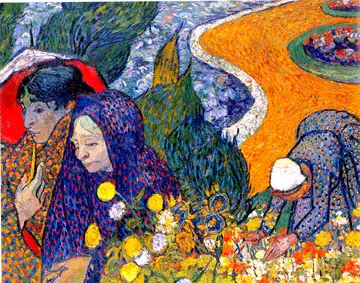The 1880s saw the beginning of the symbolist movement in France. What started as a literary phenomenon soon spread to diverse arts, including sculpture, painting, music, and theatre. Moreover, symbolist movements began in other countries, such as Russia, Italy, Belgium, and Germany. Each had its distinctive characteristics and social, political or spiritual concerns.
Symbolist visual art was characterized by a focus on the expressive, romantic and mystical, often involving symbolic figures. Symbolism proposed that works of art should use abstract or suggestive images, forms, and sounds to represent spiritual and other inspiring ideas. It abandoned the view that art should depict the world the way it appears to the senses and, instead, encouraged presenting ideas and experiences that transcend the material world. Thus, Symbolism led to the appearance of modernist abstraction in literature and art.
Paul Gauguin (1848-1903), a French painter, sculptor, ceramist, printmaker, and writer, was one of the most prominent proponents of Symbolism in the visual arts. Gauguin started out as an impressionist painter but later broke away to move in a different creative direction that explored structural, emotional, spiritual and symbolic elements lacking in Impressionism. Therefore, he is regarded as a Post-Impressionist artist.

The varied media used by Gauguin included complex symbolism that reflected his thoughts on society, sexuality, philosophy, and religion. He held the belief that art, just like religion, had the power of salvation. As a result, the boldly patterned paintings he made were often imbued with spiritual meaning. ‘Vision After the Sermon, ‘ one of his earliest works on a religious subject, is considered to be a path-breaking painting that heralded symbolist art.
However, though Gauguin’s work included religious subjects, he was not a moralist or a religious painter. He was seen more as a fabulist who evoked human predicaments with compassion, bitterness or even sarcasm, but at a high aesthetic level. The symbols in his works unfold like fables. Initially cryptic, they evoke understanding and feeling in the viewers/readers who strive to decipher their hidden meaning.
Throughout his life, Gauguin remained skeptical of blind faith and disapproved of literal interpretations of scriptures or rigid adherence to rituals. His thinking and art were influenced by theosophy, which is based on the concept of humanity and spirituality common to all ancient religions. Many theosophical principles were germane to Gauguin’s profound humanitarianism, which was reflected in several of his important artworks. He also drew upon theosophical speculations on evolution, the universe, and Nature and evoked them imaginatively in his work.
